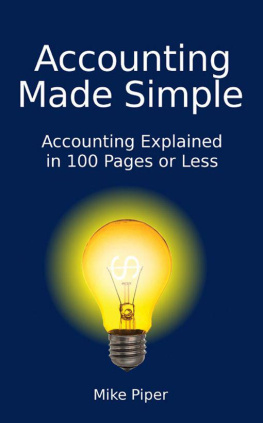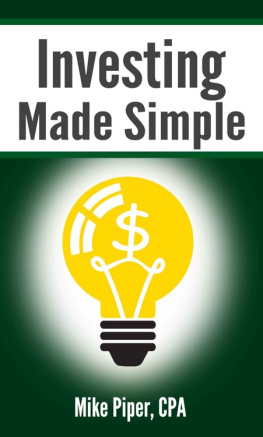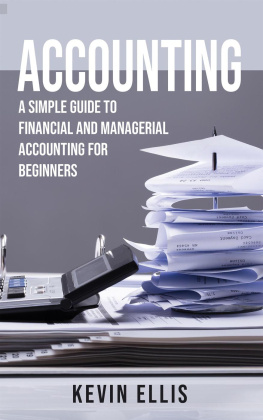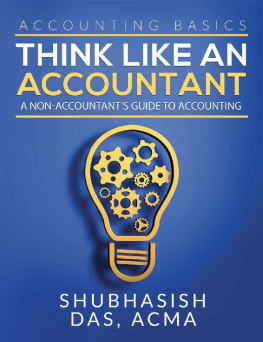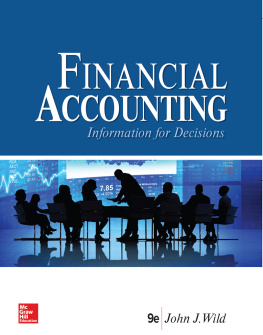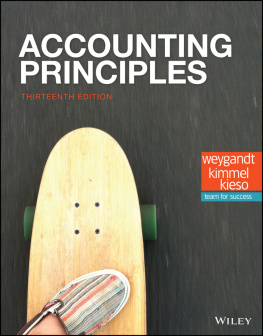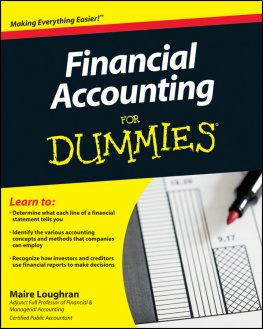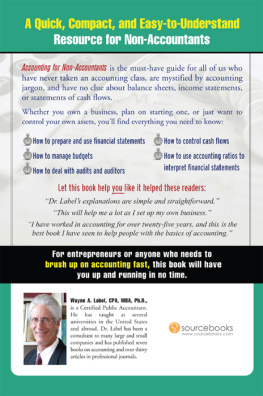To you, the reader. Thank you.
Your Feedback is Appreciated.
As the author of this book, Im very interested to hear your thoughts. If you find the book helpful, please let me know! Alternatively, if you have any suggestions of ways to make the book better, Im eager to hear that too.
Finally, if youre unsatisfied with your purchase for any reason, let me know, and Ill be happy to provide you with a refund of the current list price of the book.
You can reach me at: .
Introduction
Like the other books in the in 100 Pages or Less series, this book is designed to give you a basic understanding of the topic (in this case, accounting), and do it as quickly as possible.
The only way to pack a topic such as accounting into just 100 pages is to be as brief as possible. In other words, the goal is not to turn you into an expert. With 100 pages, its simply not possible to provide a comprehensive discussion of every topic in the field of accounting. (So if thats what youre looking for, look for a different book.)
Now, having made that little disclaimer, I should state that I do think this book will help you achieve a decent understanding of the most important accounting concepts.
So What Exactly Is Accounting?
Some professors like to say that accounting is the language of business. That definition has always been somewhat too abstract for my tastes. That said, all those professors are right.
At its most fundamental level, accounting is the system of tracking the income, expenses, assets, and debts of a business. When looked at with a trained eye, a businesss accounting records truly tell the story of the business. Using nothing but a businesss books (accounting records), you can learn practically anything about a business. You can learn simple things such as whether its growing or declining, healthy or in trouble. Or, if you look closely, you can see things such as potential threats to the businesss health that might not be apparent even to people within the company.
Where Were Going
This book is broken down into two main parts:
- A discussion of the most important financial statements used in accounting: How to read each one, as well as what lessons you can draw from each.
- A look at accounting using Generally Accepted Accounting Principals (GAAP), including:
- Topics such as double-entry bookkeeping, debits and credits, and the cash vs. accrual methods.
- How to account for some of the more complicated types of transactions, such as depreciation expense, gains or losses on sales of property, inventory and cost of goods sold, and so on.
So lets get started.
PART ONE
Financial Statements
CHAPTER ONE
The Accounting Equation
Before you can create financial statements, you need to first understand the single most fundamental concept of accounting: The Accounting Equation.
The Accounting Equation states that at all times, and without exceptions, the following will be true:
| Assets = Liabilities + Owners Equity |
So what does that mean? Lets take a look at the equation piece by piece.
Assets: All of the property owned by the company.
Liabilities: All of the debts that the company currently has outstanding to lenders.
Owners Equity (a.k.a. Shareholders Equity):
The companys ownership interest in its assets, after all debts have been repaid.
Lets use a simple, everyday example: homeownership.
EXAMPLE: Lisa owns a $300,000 home. To pay for the home, she took out a mortgage, on which she still owes $230,000. Lisa would be said to have $70,000 equity in the home. Applying the Accounting Equation to Lisas situation would give us this:
| Assets | = | Liabilities | + | Owners Equity |
| $300,000 | = | $230,000 | + | $70,000 |
In other words, owners equity (the part that often confuses people) is just a plug figure. Its simply the leftover amount after paying off the liabilities/debts. So while the Accounting Equation is conventionally written as:
Assets = Liabilities + Owners Equity,
it might be easier to think of it this way:
Assets Liabilities = Owners Equity
If, one year later, Lisa had paid off $15,000 of her mortgage, her accounting equation would now appear as follows:
| Assets | = | Liabilities | + | Owners Equity |
| $300,000 | = | $215,000 | + | $85,000 |
Because her liabilities have gone down by $15,000and her assets have not changedher owners equity has, by default, increased by $15,000.
My Asset is Your Liability
One concept that can trip up accounting novices is the idea that a liability for one person is, in fact, an asset for somebody else. For example, if you take out a loan with your bank, the loan is clearly a liability for you. From the perspective of your bank, however, the loan is an asset.
Similarly, the balance in your savings or checking account is, of course, an asset (to you). For the bank, however, the balance is a liability. Its money that they owe you, as youre allowed to demand full or partial payment of it at any time.
| Chapter 1 Simple Summary |
- A companys assets consist of all the property that the company owns.
- A companys liabilities consist of all the debt that the company owes to lenders.
- A companys owners equity is equal to the owners interest in the companys assets, after paying back all the companys debts.
- The Accounting Equation is always written as follows:
Assets = Liabilities + Owners Equity - However, its likely easier to think of the Accounting Equation this way:
Assets Liabilities = Owners Equity.
|
CHAPTER TWO
The Balance Sheet
A companys balance sheet shows its financial situation at a given point in time. It is, quite simply, a formal presentation of the Accounting Equation. As youd expect, the three sections of a balance sheet are assets, liabilities, and owners equity.
Have a look at the example of a basic balance sheet on the following page. Lets go over what each of the accounts refers to.
Assets
Cash and Cash Equivalents: Balances in checking and savings accounts, as well as any investments that will mature within 3 months or less.
| Balance Sheet |
| Assets |
| Cash and Cash Equivalents | $50,000 |
| Inventory | $110,000 |
| Accounts Receivable | $20,000 |
| Property, Plant, and Equipment | $300,000 |
| Total Assets: | $480,000 |

